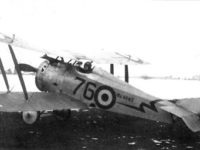Despite its poor performance, the Hanriot HD.1 was one of the most built French fighter pilots of the First World War.
Development and construction:
René Hanriot was already insolvent in aircraft construction before the First World War, but his company Société des monoplans Hanriot went bankrupt in 1913. It was not until the beginning of 1916 that he joined forces with the designer Emile Dupont, who had previously developed aircraft for the Deperdussin, Ponnier, Morane and Nieuport companies to form his own company.
The first orders were for the British Sopwith 1½ Strutter aircraft to be built under license, but Dupont also began developing his own aircraft. In doing so, he was based on the British Bristol Scout and Sopwith Pup aircraft, with the majority of them adopting their basic characteristics in his own aircraft.
The result was a single-seat fighter, which was equipped with two wings of different lengths, which, however, gave the pilot a very good view. The fuselage and the wings consisted of a fabric-covered wooden structure with duralumin sheets in the front fuselage area for stability. The tail units were also reinforced with a tubular steel frame.
The 110 HP Le Rhône 9J rotary engine was selected as the engine, as it could be produced in sufficient quantities and was available at the time. Due to the rather lower performance compared to other fighters, the engine was repeatedly exchanged for more powerful variants during the war.
The first flights with the prototypes took place in June 1916, after which the aircraft was presented to the French Air Force. However, since they opted for the more powerful SPAD S.VII aircraft, orders for the Hanriot HD.1 were only received from the Italian and Belgian air forces, with a volume of 1.125 units. Thus the Hanriot HD.1 was one of the most built fighter aircraft of the First World War.
Use in the First World War:
From November 1916, the first Hanriot HD.1 aircraft were used at the front in Italy to replace the outdated Nieuport aircraft. Compared to the aircraft of the Austro-Hungarian Air Force, the Oeffag D.III, the aircraft turned out to be slower than more manoeuvrable.
In the course of 1917 the Belgian Air Force was also equipped with Hanriot HD.1 aircraft which were used on the northern western front.
Use after the First World War:
After the First World War, some of the Hanriot HD.1 aircraft remained in the French Air Force. The USA, Switzerland, Ecuador and Venezuela also bought some.
In France and the USA in particular, these were used for experiments with ships. In the USA, a launch pad was installed on the battleship USS Mississippi from which Hanriot HD.1 aircraft could launch.
In France, however, the tests were concentrated on the ship Béarn, which had been converted into an aircraft carrier. A 45 meter long wooden platform was placed there on which the first successful landing of an aircraft on such a deck could take place on October 20, 1920.
Technical specifications:
| Description: | Hanriot HD.1 |
| Country: | France Italy under license |
| Type: | Fighter plane |
| Length: | 5,85 meters |
| Span: | 8,70 meters |
| Height: | 2,55 meters |
| Weight: | 400 kilograms empty |
| Crew: | Max. 1 |
| Engine: | a Le Rhône 9J radial engine with 110 HP (81 kW) |
| Maximum speed: | 184 kilometers per hour |
| Range: | Max. 550 kilometers |
| Armament: | 1 - 2 machine guns 7,7 mm |
This post is also available in:
 Deutsch (German)
Deutsch (German)  Français (French)
Français (French)  Italiano (Italian)
Italiano (Italian)  简体中文 (Chinese (Simplified))
简体中文 (Chinese (Simplified))  Русский (Russian)
Русский (Russian)  Español (Spanish)
Español (Spanish)  العربية (Arabic)
العربية (Arabic)















